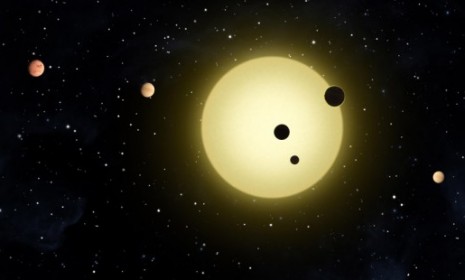NASA's 'astonishing' find: 54 planets that can sustain human life
The space agency has identified dozens of planets that may be hospitable to earthlings. Could intelligent life be living on one of them?

In the past, scientists have had trouble spotting faraway planets where life could exist as we know it on Earth. But thanks to the Kepler telescope, which has been orbiting the sun since 2009, NASA has detected an "astonishing" 1,235 possible planets outside the Earth's solar system — and 54 of them have conditions conducive to liquid water, meaning they might be habitable. (Watch a report about the findings.) The discovery has astronomers giddy, because until now only two known planets were thought to be in the "Goldilocks zone," where conditions are just right for supporting human life. Here's a guide to the bonanza of new planets:
How did scientists find the planets?
Kepler, an orbiting NASA telescope, has been gazing into a small section of sky near the Northern Cross. By measuring the brightness of the 156,000 stars that reside there, Kepler can detect whether planets are crossing the stars' paths. Kepler is able to detect much smaller objects than its predecessors, and a significant number of the planets it has found are only slightly bigger than Earth. Scientists are not completely sure that all the objects they've discovered are planets — they still need to make sure that intergalactic optical illusions aren't responsible for what they're seeing. But preliminary statistical steps show that 85 to 90 percent of the objects Kepler uncovered are real planetary bodies, not aberrations.
The Week
Escape your echo chamber. Get the facts behind the news, plus analysis from multiple perspectives.

Sign up for The Week's Free Newsletters
From our morning news briefing to a weekly Good News Newsletter, get the best of The Week delivered directly to your inbox.
From our morning news briefing to a weekly Good News Newsletter, get the best of The Week delivered directly to your inbox.
What are the chances of finding another Earth?
"This is the first big step" toward answering that ancient question, says Sara Seager at M.I.T., as quoted by The New York Times. At first glance, says Dennis Overbye at the Times, not one of them appears to be a "cosmic Eden fit for life as we know it." But astronomers have only spent four months on their planet-seeking mission, and by comparison, "if intelligent aliens were studying our solar system... they would see Earth in transit just once a year," according to CBS News. The fact that scientists have found so many planets in such a short time has fostered optimism about finding one that is habitable.
What about finding intelligent life?
"The search for radio transmissions from these latter worlds is already underway," says astronomer Seth Shostak at The Huffington Post. It's possible that new, Earth-like planets are "only habitable, and not inhabited." Or maybe "they host only intellectually challenged life — alien equivalents of paramecia, pond scum, or pterodactyls." But extrapolating from these findings, there could be 30,000 potentially habitable worlds within 1,000 light years of Earth. That's a lot of planets, so when Kepler finds more of them you can bet "they'll be getting increased scrutiny for the tell-tale signs of intelligence."
A free daily email with the biggest news stories of the day – and the best features from TheWeek.com
Sources: NY Times, Huffington Post, CBS News, Christian Science Montior
-
 6 homes with fall foliage
6 homes with fall foliagefeature An autumnal orange Craftsman, a renovated Greek Revival church and an estate with an orchard
-
 Musk wins $1 trillion Tesla pay package
Musk wins $1 trillion Tesla pay packageSpeed Read The package would expand his stake in the company to 25%
-
 Political cartoons for November 7
Political cartoons for November 7Cartoons Friday’s political cartoons include a party at Mar-a-Lago, a handy chart for ICE, the Republican train wreck and Nancy Pelosi's retirement